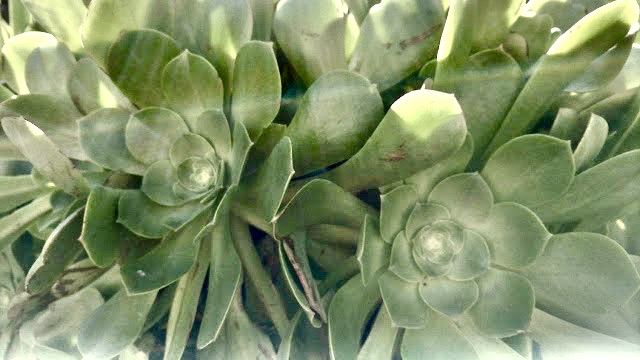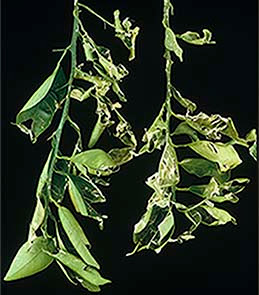
Winter weather can damage plants, particularly succulents

|
|
A hen and chicks succulent shows tiny nicks and other hail damage. (Photo: Debbie Arrington)
|
Cold and stormy weather this week has had an impact on more than traffic and holiday celebrations.
Hail can harm tender plants, particularly succulents. These fleshy favorites already were uncomfortable from too much rain and low temperatures. As for hail, it causes tiny nicks and scarring on succulents’ tender leaves or, in worse cases, beats them to a pulp.
Hail also punches holes in big tender foliage on plants such as canna or ginger. Since our winter temperatures had been mostly mild, these plants were holding onto their leaves later than usual.
But a big hailstorm also can tear up foliage on citrus and evergreen shrubs. It can damage fruit and scar the tree.
Most plants cope with winter hail OK; winter survival is a big reason so many perennials, trees and shrubs go dormant during these cold months.
Spring hail can do the most damage; it knocks tender new growth and spring blooms off fruit trees and trashes little seedlings.
According to UC master gardeners, “impact from hail can tatter leaves, cause sunken scars on the outer and upper surfaces of fruit and twigs, and increase plant susceptibility to wound-related maladies.”
Wounds occur on the side of the plant that faced the storm directly, the master gardeners say.
“Hailstones usually tatter, tear, and pit leaves and scar fruit,” they add. “If hail impacts young fruit, scars can become large and distinctive as the rind enlarges.
“Sometimes hail causes elliptical wounds in bark or breaks twigs. Large wounds can cause branches to develop cankers, become girdled, and die. Severe fire blight can occur in susceptible species shortly after hail damage causes wounds through which pathogens enter hosts.”

|
|
These citrus leaves show hail damage. (Photo courtesy
UC Integrated Pest Management)
|
In areas where hail is common, gardeners keep buckets and trash cans at the ready to use as instant hail shelters to cover tender plants. But in California’s Central Valley, hail is considered rare.
Most hail damage is cosmetic; it can be pruned off and the plant will grow back healthy.
Temperatures have been unusually cold, too. If there’s frost damage as well as hail damage, wait until March or April to prune off browned branches. That injured area will help protect the rest of the plant from further cold.
However, succulents damaged by hail and frost may not survive this cold and wet winter. Fleshy leafed plants can bruise and show lasting scars of hail impacts. In addition, succulents are filled with water. Their cells can freeze, then burst, turning the foliage to mush.
Hail usually melts before it can cause any frostlike damage, but exposure to temperatures below 32 degrees for 30 minutes or more can cause significant damage to fleshier succulents.
According to succulent experts, it’s not just the cold that causes damage, but the exposure to bright sunlight when frozen. The plants need to thaw gradually to avoid bursting their cells. Shade them with a sheet or cardboard to protect them while they thaw.
Due to an abundance of rain this winter, succulents already are at risk of rot. They can survive frosty conditions much better with dry soil than wet. If planted in containers, make sure to tip out excess water.
Because of this rot risk, prune off mushy foliage and stems from damaged succulents immediately to encourage new healthy growth. Crassulas, aeoniums, euphorbias and kalanchoes are at greatest risk.
For more on hail damage: http://ipm.ucanr.edu/PMG/GARDEN/ENVIRON/hail.html
Comments
0 comments have been posted.Sacramento Digs Gardening to your inbox.
Sites We Like
Garden Checklist for week of July 21
Your garden needs you!
* Keep your vegetable garden watered, mulched and weeded. Water before 8 a.m. to reduce the chance of fungal infection and to conserve moisture.
* Feed vegetable plants bone meal, rock phosphate or other fertilizers high in phosphate to stimulate more blooms and fruiting. (But wait until daily high temperatures drop out of the 100s.)
* Don’t let tomatoes wilt or dry out completely. Give tomatoes a deep watering two to three times a week.
* Harvest vegetables promptly to encourage plants to produce more. Squash especially tends to grow rapidly in hot weather. Keep an eye on zucchini.
* Pinch back chrysanthemums for bushy plants and more flowers in September.
* Remove spent flowers from roses, daylilies and other bloomers as they finish flowering.
* Pinch off blooms from basil so the plant will grow more leaves.
* Cut back lavender after flowering to promote a second bloom.
* It's not too late to add a splash of color. Plant petunias, snapdragons, zinnias and marigolds.
* From seed, plant corn, pumpkins, radishes, winter squash and sunflowers.